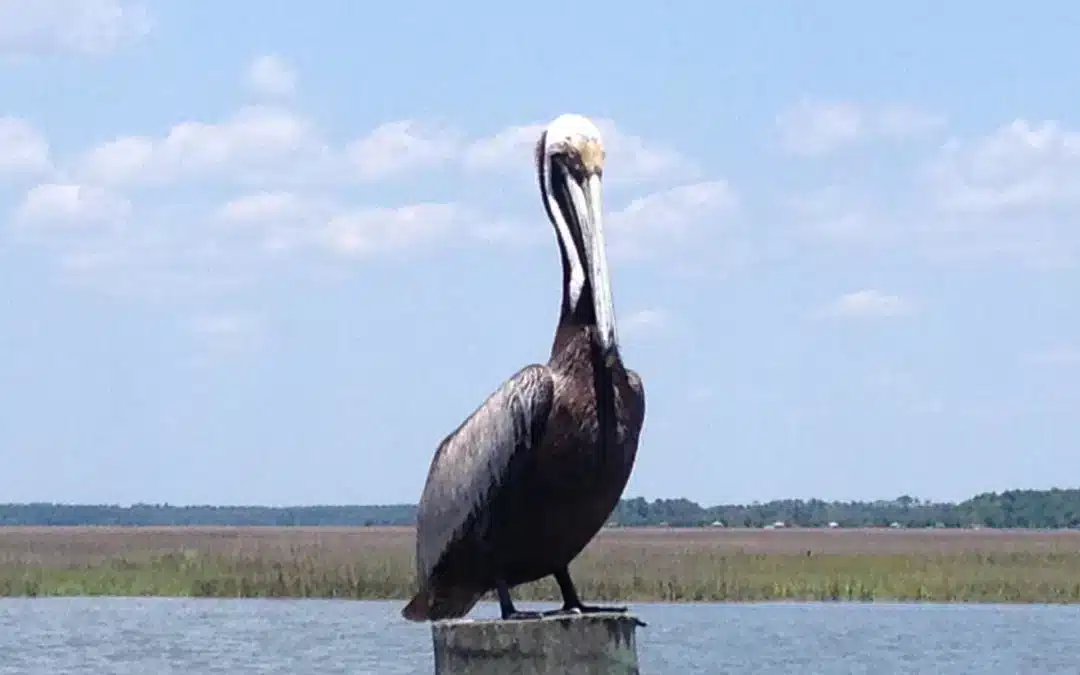Gliding gracefully over the water next to an OM Sailing Charter you will discover Charleston’s most social bird, the Brown Pelican (Pelecanus occidentalis). Often seen lounging on pilings or sandbars with its head resting on its neck, gliding low over the waves in a v-formation, or diving spectacularly into Charleston Harbor, these water birds offer sweet messages from an inspiring past.
IDENTIFYING THE BROWN PELICAN
As soon as you identify the Brown Pelican from the cockpit or deck of an Om Sailing Charter, you will never forget them. This large stocky brown seabird with its long neck has a distinctive large pouch that hangs form the lower half of its long straight bill. This pouch allows them to scoop fish along with up to 2.6 gallons of water and draining the water out before swallowing the fish whole.
Watching the distinct flight pattern of this bird from an Om Sailing Charter, you will be struck by the pelican’s wingspan – up to 7 feet long. The gregarious bird usually flies in flocks all year round, as they stay in Charleston Harbor throughout the winter. While they have an awkward gate on land, they are both strong swimmers and masterful fliers.
THE MYTH OF CHARLESTON’S BROWN PELICAN’S EYESIGHT
While the captain of Om Sailing Charters is likely to delight you all sorts of facts on Charleston Harbor’s wildlife, it is actually a myth that the pelican goes blind from diving. While the bird may indeed lose its eyesight, it’s not what you might think.
Of the eight pelican species, the brown pelican is the one you see in Charleston Harbor and the only one that dives. And dive it does. With its sharp eyesight, it can spot fish from heights of 20 to 60 feet. Once it spots dinner, it will fold its wings back, point its head down, and splash into the water, tucking and twisting to the left to protect its trachea and esophagus from impact. It has air sacs under the skin to cushion the blow and bring the bird back up to the surface.
The myth is, after years of diving into the ocean like this, the bird loses its eyesight in old age and is unable to hunt. While Pelicans can go blind, it is not the diving that causes its blindness, but rather avian botulism from diseased fish or chemical pollution.
THE CONSERVATION OF CHARLESTON’S BROWN PELICAN
Pollution is by far the largest threat to Charleston Harbor’s majestic bird.
In the past, the use of DDT as a pesticide greatly affected the calcium metabolism of pelicans, causing their eggshells to become thinner and more fragile. Their population decreased so dramatically that in 1970, the U.S. Fish and Wildlife Service listed the brown pelican as endangered. In 1972, the Environmental Protection Agency banned the use of DDT in the United States. The brown pelican population on the Atlantic coast and in Charleston Harbor has fully recovered, but the brown pelicans on the Pacific coast remain on the Endangered Species List.
Since they breed, roost, and forage near shipping channels, the Brown Pelican is highly susceptible to oil and gas spills. Disturbance from human activity in their coastal nesting habitats can cause problems, as panicked pelicans often abandon or accidentally destroy their nests. Abandoned fishing line also threatens this species along with many other marine animals. It has been estimated that more than 700 adult and immature pelicans die each year in Florida alone from entanglement in sport-fishing gear.
SUBTLE MESSAGE FROM THE BROWN PELICAN
While relaxing on an Om Sailing Charter, the pelican is bound to cross your path. If you feel a connection to this bird, it might be a sign to forgive yourself and let go of negative feelings. The brown pelican spirit shows us that not being weighed down by unnecessary things can make us soar higher and reach new heights. It also reminds us to work peacefully with others to achieve a common goal. Sometimes we need to let our eccentricities and our ego to take a backseat so that we can work harmoniously with others and get our desired results.
FUN FACTS OF CHARLESTON’S BROWN PELICAN
As you relax and enjoy all of the fun on an Om Sailing Charter, be sure to catch up on your pelican facts.
- A pelican’s bill can hold three times more than its stomach can—nearly three gallons of fish and water. At the end of a successful dive, the pelican drains the water from its pouch and swallows the whole fish head first—after turning it if necessary. A large hook at the tip of a pelican’s bill helps hold the squirming fish.
- Highly social all year, pelicans breed in colonies of up to several thousand pairs—usually on small islands where they are free from terrestrial predators.
- The young can fly and fend for themselves after 3 months but take 3–5 years of age to reach sexual maturity.
- The brown pelican has a wingspan up to 7 feet (2.1 m); weighs up to 10 pounds (4.5 kg).
- Charleston’s majestic sea bird dines on anchovies, herring, minnows and sardines.
Get in touch.
[wpforms id="24859" title="false" description="false"]
About Om Sailing Charters.
Om Sailing Charters is Charleston's premier yacht charter service. We offer the largest and most luxurious catamaran in Charleston Harbor. This is not just a sail on the harbor this is a glimpse of the sailing lifestyle. Professionally captained by a US Coast Guard licensed and rated Master, we provide our guests total confidence in their safety. Located less than five miles from the heart of Downtown Charleston, we invite you to read our many 5-star reviews on Trip Advisor. Contact us today to schedule your Sunset Cruise in Charleston South Carolina.



